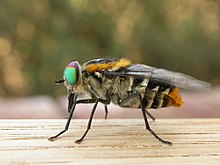Scaptia auriflua
Appearance
| Scaptia auriflua | |
|---|---|

| |
| Scientific classification | |
| Domain: | Eukaryota |
| Kingdom: | Animalia |
| Phylum: | Arthropoda |
| Class: | Insecta |
| Order: | Diptera |
| Family: | Tabanidae |
| Subfamily: | Pangoniinae |
| Tribe: | Scionini |
| Genus: | Scaptia |
| Species: | S. auriflua
|
| Binomial name | |
| Scaptia auriflua | |
| Synonyms | |
Scaptia auriflua, the flower-feeding march fly, is a species of horse flies that occurs in Australia. Unlike other march flies this species does not bite and does not feed on blood, it strictly drinks nectar.[2][3]
Description
[edit]Adults are about 10 millimetres (0.4 in) in length and mimic bees with dense hair and a golden coloration. Their eyes meet in the middle and the eye coloration differs from light source to light source.[4]
References
[edit]- ^ a b Donovan, E. (1805). An epitome of the natural history of the insects of New Holland, New Zealand, New Guinea, Otaheite, and other islands. London: Rivington. pp. iv + [167] pp. + [41] pl. Retrieved 7 October 2022.
- ^ González, C. R.; Sanhueza, Y. (2004). "Comparative study of mouthparts of the female of three species of Scaptia (Scaptia) Walker from Chile (Diptera: Tabanidae)". Acta Entomologica Chilena (PDF Adobe Acrobat). 28 (1). Instituto de Entomología.
- ^ Moucha, J. (1976). "Horse-flies (Diptera: Tabanidae) of the World. Synoptic Catalogue" (PDF). Acta Entomologica Musei Nationalis Pragae Supplements. 7: 1–320. Retrieved 11 September 2022.
- ^ "Flower-feeding March Fly - Scaptia auriflua". Archived from the original on 2008-07-05. Retrieved 2009-02-24.
 Media related to Scaptia auriflua at Wikimedia Commons
Media related to Scaptia auriflua at Wikimedia Commons
